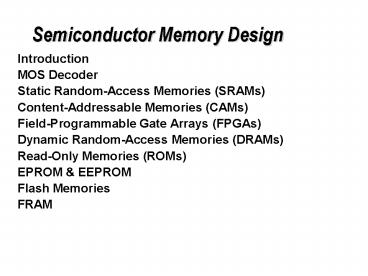Semiconductor Memory Design - PowerPoint PPT Presentation
1 / 58
Title:
Semiconductor Memory Design
Description:
FRAM. Memory Organization. May select 1, 4, 8, 16,32, 64. Col. In a Row. Memory Design ... FRAM. Ferroelectric material. Nonvolatile. Destructive read-out. Need ... – PowerPoint PPT presentation
Number of Views:276
Avg rating:3.0/5.0
Title: Semiconductor Memory Design
1
Semiconductor Memory Design
- Introduction
- MOS Decoder
- Static Random-Access Memories (SRAMs)
- Content-Addressable Memories (CAMs)
- Field-Programmable Gate Arrays (FPGAs)
- Dynamic Random-Access Memories (DRAMs)
- Read-Only Memories (ROMs)
- EPROM EEPROM
- Flash Memories
- FRAM
2
Memory Organization
May select 1, 4, 8, 16,32, 64 Col. In a Row
3
Memory Design
4
Memory Timing
5
Memory Decoders
6
Two-Level Decoder (6-bit addr)
7
Ex 8.1 Sizing of Two-Level Decoder
- Size the decoder by using FO4 rules (optimal
stage4) and Cin(LE ?BE? Cout)/4 for each stage - Output loading1
- Branch Effort (BE) of pre-decoder16
8
Ex 8.1 Solution
- LE NAND3 5/3
- Input C (5/3)(1/4)2
- BE(preDec) 16
- Cin,inv 16 (5/3)(1/4)3
- Cin,nand2 16(4/3) (5/3)(1/4)4
9
SRAM Cell
- Operations
10
SRAM Cell Layout
M2
- ?30??40?
CWL/cell(2CgateCwire)
Cbit(CS/DCwireCcontact)
11
Wordline and bitline
Cword(2CgateCwire)? /row
Cbit(CS/DCwireCcontact)? /col.
12
Read operation
- IM3 Sat IM1 lin
- Icell C bit ??V/??
- See Ex. 8.2 in pp. 373-374
13
Write operation
- IM6 Sat IM4 lin
14
SRAM Column I/O Circuitry
- Column Pull-ups
15
PC Circuitry
16
Column Selection (1)
17
Column Selection (2)
18
Write Circuitry
19
Read Circuitry
20
Sense Amplifier(1)
Differential SA
?? Cout ??V/ Iss
21
Sense Amplifier(2)
Latch-based
22
Replica for SA and CLK enable
- SenseEnable Same delay of Bitline
23
Replica Cell design
- To match the timing of actual column delay
- 0.18V in 256 celsl
- 1.8V in 26 cells
24
Memory Architecture
25
Divided WL to Reduce PD Delay
26
Bitline Partitioning to Reduce Delay
27
Content-Addressable Memory
- Called Associative Memory
- Lookup Scheme
- Tag Previous stored keyword
- Store randomly
- SRAM architecture
- Used in Cache
- As Internet routing
- Table
28
CAM Lookup Array
- ? Diff XOR1
- NMOS on
- Machi 0
- ? Same XOR0
- NMOS off
- Machii1 (precharged)
- Select only one or none row
29
CAM Cell
- M7, M8, M9, M10
- XOR
- Compare (q, q) with (Tagline, Tagline)
- 20 to 30 gt Area of SRAM cell
- Taglines
- must start low to
- avoid discharge in precharge phase
30
SRAM Array in CAM
- Invalid rows if not fully used
- Timing is critical since Matchlines are initially
all prechaged - Write data same as SRAM operations except
Tagelines start low
31
Modified CAM Cell
- Improve Speed
- M7 or M9 on if Gate1
- GND passes and waits for Tagline signals
- In Original Cell
- Tagline signals arrive
- Then GND can passes
Original Cell
32
Field-Programmable Gate Array
- Rapid Implementation
- Verify function but not timing
- Overall architecture
- Routing Channel
- I/O blocks
- PLBs
33
FPGA Architecture
34
PLB Structure
35
PLB Structure Example
36
Programmable Connections
37
I/O Block
38
Dynamic RAM Evolutions
- SRAM w/o pull-up
- 3T DRAM
39
DRAM ell
40
DRAM Configuration
- Dummy cells with half Cap.
41
Sense-refresh Circuitry
42
Block diagram of 64kbit DRAM
43
Read-Only Memories
44
ROM Arrays
45
Current SA
Current Mirror
46
EPROM
47
EPROM Write/Erase Processes
48
EEPROM
FN tunneling
49
EEPROM write/Erase
50
EEPROM Read
51
Flash Memory
- NOR Structure
- Write Hot Carriers Injection
- Erase Fowler-Nordheim Tunneling
52
Write and Erase
53
Flash Read Operation
54
NAND Flash
55
FRAM
- Ferroelectric material
- Nonvolatile
- Destructive read-out
- Need write back similar to DRAM
- Drawback (not semiconductor memory)
- Cost, Speed, Size
- Advantages
- Less power
- high density/reliability
56
FRAM
- Cap Perovskite Crystal be polarized in 2
directions - Loigc-1 Vcc
- Logic-0 ?Vcc
57
Summary of Semiconductor Memories
58
Comparison Table
Endurance Cycle 102 105 106 1010-1012
Cell Size S L S S
Speed F Med F F
Power H Med L L
Erase typ UV FN FN Polarize
Erase Res. Full Mem Bit/Byte Block Bit
Memory EPROM EEPROM Flash FRAM
Prog type HCI FN HCI/FN Polarize































